hammerflügel
stein-schule
süddeutsch ca. 1780
Originally preserved south German grand after Johann Andreas Stein's tradition
Mechanism: Stein. slightly modified
Range: 5 octaves, 61 keys (F1-f3)
Levers, Pedals: one knee lever: dampers
Signature: without
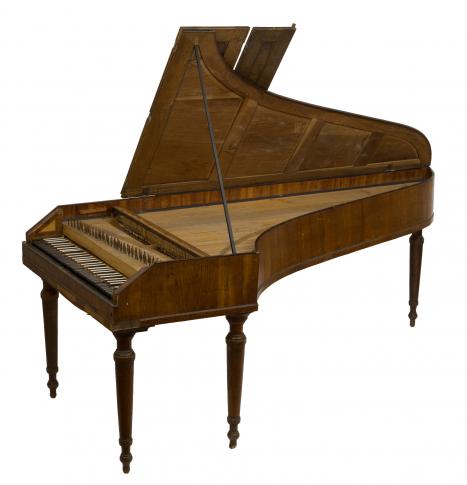
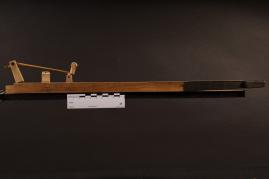
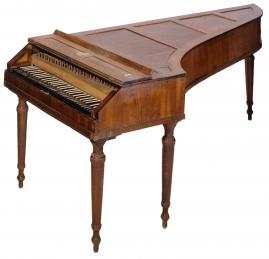
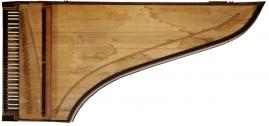
The instrument has no maker's- (or possessor's) signature. Insofar it is only to be attributed by external or style criteria. It is obviously highly similar but also different in significant details to the preserved grands by Johann Andreas Stein of the 1780s. In all likeliness therefore it belongs to the wider circle or school of Stein.
The lack of a (even hidden) signature as such is suspicious. The right to sign an instrument was a master's privilegue. So a first possible explanation could be that the instrument was a journeyman's make. It is, however, a remarkably refined work revealing an intensively refined and experienced standard. Even a journeyman's work was usually supervised by a master who cared for attention to his designs.
The most striking feature of this instrument, however, is a unique modification for fine adjustment of the tilt of hammer capsules that cannot be found in Stein. Each hammer capsule has an additional adjustment screw, alongside the usual screw that secures the capsule to the key. This additional screw can be finely adjusted with a common watch key, an idea that significantly facilitated the regulation of the hammer strike and saved considerable amount of time during the regulation of the mechanics.
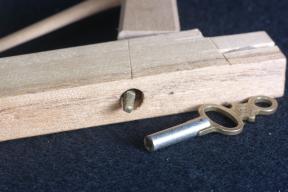
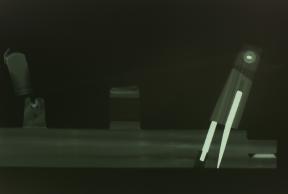
The X-ray image shows both the adjusting screw (left) and the actual fixation screw (right) for the hammer capsule, as used exclusively by Stein.
Around Stein, such ideas seem to have engaged several piano builders in this process. During our documentation of a similarly anonymously transmitted grand piano from the collection of the Klassik Stiftung Weimar, a construction was noted that achieved a comparable effect with the help of a small wooden wedge driven under the capsule. The manufacturer of this Weimar instrument could be identified as Johann Schenck in Weimar based on a hidden pencil inscription inside, a direct student of Johann Andreas Stein. Although he is not a candidate for the manufacturer of our instrument due to the also evident differences, he nonetheless points to the presumed circle of manufacturers.
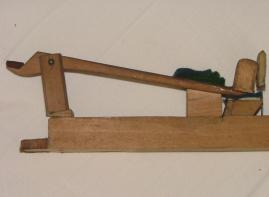
The circle of former apprentices, journeymen, and thus students of Johann Andreas Stein, known today, extends bio- and geographically far beyond Stein's workshop at Augsburg's Ulrichsplatz. Many of them moved to more distant places, such as his children Nanette and Matthäus Andreas to Vienna, his cousin Georg Marcus to Durlach, whose son Johann Andreas Stein (the younger) later moved to Riga, Volmar (Valmiera), and Pernau (Pärnu), his nephew Johann Georg Doppler to Nürnberg via Speyer and Bayreuth, Joseph Hunn to Berlin via Prague, J.C. Bulla and Johann David Schiedmayer to Erlangen, Johann Schenck to Weimar, and Johann Ev. Schmidt to Salzburg. It is likely that frequent information transfer occurred through personal presence or family contacts.
Additionally, there is a circle of copyists and imitators of Stein, which begins with contemporary Augsburg successors following the closure of Stein's workshop, such as Senft, Wirth, or Zauscher. However, it certainly extends well beyond Augsburg, as individual instruments by Stein served as inspiration and templates for copying. Some are only evident by documentary evidences, yet a concrete correlation in this specific case can only be made with preserved instruments that retain original substance. Stein's instruments themselves formed a level of mediation, the range of which can only be outlined roughly.



